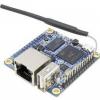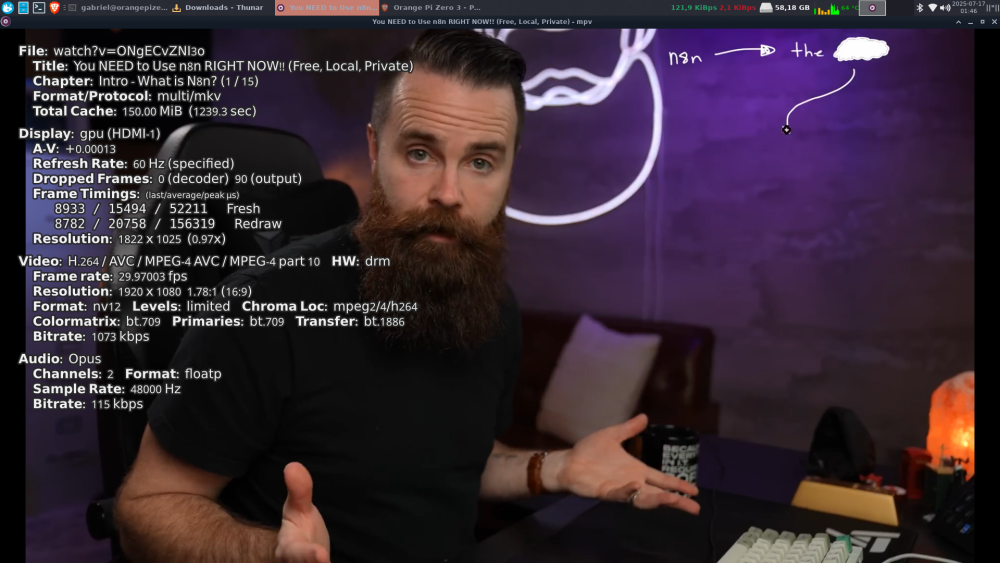All Activity
- Past hour
-
What did you do to fix it? Others that come across this may find it useful.
- Today
-
I believe I have installed all the components as mpv seems to detect ffmpeg-v4l2-request. Unless adding --no-audio I get complaints about hdmi audio failing. From what I can tell mpv is at least trying to run on the video engine but something is not right:mpv-log.txt From when I tested this once before I got errors relating not being able to reserve enough memory (-12). I guess I need to hunt for cedrus patches as well as lowering CMA buffer size which conversely in the past allowed me to run a desktop image without crashing at boot. In truth the A10 is so old now that it is likely the video engine on will ever be fully supported.
-
After enabling the rk3588-hdmirx overlay in armbian-config device tree overlays, whenever I boot, I am greeted with multiple hdmirx (fdee0000.hdmirx-controller: hdmirx_wait_lock_and_get_timing HDMI pull out, return!) errors on boot. On a previous install, the hdmirx errors would block the entire boot process and it would just hang forever. I do not know the exact cause, but the issues seemed to arise after I ran this command to disable the X Display Server "systemctl set-default multi-user.target". The errors could only be resolved if I plugged in the sd card into another device and removed rk3588-hdmirx from overlays in /boot/armbianEnv.txt . I have since reinstalled Armbian, but the errors still appear during the boot process, however now they do not block the boot process and I am able to successfully boot into Armbian. Is there any solution to get rid of these errors, or ensure that the "fdee0000.hdmirx-controller: hdmirx_wait_lock_and_get_timing HDMI pull out, return!" error doesn't block the boot process without disabling hdmirx? These are my current device details: .. orangepi@orangepi5-plus `:]x**j-,' ----------------------- .,+t***********z\<" OS: Armbian 25.5.1 noble aarch64 ?******************; Host: Orange Pi 5 Plus '*n` .'`^,;;,^`'. ,cc. Kernel: Linux 6.1.115-vendor-rk35xx -<. .[l Uptime: 30 mins // ^^ ^^ \\ Packages: 1822 (dpkg) !^ ^^ ": Shell: bash 5.2.21 'tt}` !~]rj_ ")t/. Display: 3840x2160 @ 60 Hz Itttt?' ~~]rr] `{tttt, DE: KDE Plasma 6.3.90 \tttttt!""I_]r("""~tttttt1 WM: KWin (Wayland) '_tttttttttttt)ftttttttttttti. WM Theme: Breeze \*ztttttttttttttttttttttttttf**[ Theme: Breeze (Dark) [Qt], Yaru [GTK3] l**c)tttttttttttttttttttttttt(z**, Icons: breeze-dark [Qt], Yaru [GTK3] .z*x.`tttttttttttttttttttttttt.`u*n Font: Noto Sans (10pt) [Qt] >` (tttttttttttttttttttttt] "I Cursor: breeze (24px) ,tttttttttttttttttttttt` Terminal: konsole 25.4.1 ./tttttfttttttttfttttt( CPU: rk3588 (8) @ 2.40 GHz 'I)))(\()(tt))|\()({;' GPU: Mesa Mali-G610 (Panfrost) .~~~~~~~|)~~~~~~~< Memory: 4.34 GiB / 15.58 GiB (28%) '[)))))1|()))))))? Swap: 0 B / 7.79 GiB (0%) ",,," ",,,^ Disk (/): 7.82 GiB / Here is the dmesg log after boot up, the hdmirx errors appear near the end: boot_errors.txt
-
I'm reopening this old 3D because I figured out why some of you had the problem of only seeing 1GB (about 800MB free RAM) on a 2GB board. I didn't have the problem simply because I never bricked my board and didn't need to flash the firmware. After bricking the board, I also had the RAM problem and realized it was due to the firmware, probably on a board with 1GB of RAM. If anyone has a link to the firmware for a 2GB board, I'll explain the solution I found. It involves loading Armbian ophub onto a USB stick and using the full eMMC restore with the saved image armbian-ddr command, of which I have a copy. This way, the board reverts to the factory Android image loaded on the eMMC, and Linux sees 2GB of RAM. I don't know the technical reason for this, but I think the emmc image contains some sort of BIOS that precedes the loading of uboot and the board's dtb. After restoring the original emmc image, the tx3 logo returned; it was no longer there with the other firmware. Soon the link of my image with 2GB ram for fake tanix tx3mini with soc S905L2-B so if anyone is still playing with this board can see the 2GB of ram again.
-
tried mining feathercoin, git clone https://github.com/ghostlander/cpuminer-neoscrypt lots of missing dependencies to build that apt install automake autoconf-archive pkg-config libtool libcurl4-openssl-dev but once done it is autogen.sh, configure, make next register on https://www.mining-dutch.nl/ then run ./minerd -D --algo=neoscrypt --url=stratum+tcp://mining-dutch.nl:9993 -u username.worker1 -p d=10 a whopping 1.1 k hash/s on each core, well not very impressivve, but it mines i think this is no Neon SIMD Stop monitoring using [ctrl]-[c] Time CPU load %cpu %sys %usr %nice %io %irq Tcpu C.St. 20:22:02 1416 MHz 3.90 100% 0% 0% 99% 0% 0% 53.2 °C 0/7 20:22:07 1416 MHz 3.91 100% 0% 0% 99% 0% 0% 53.2 °C 0/7 20:22:12 1416 MHz 3.92 100% 0% 0% 99% 0% 0% 53.4 °C 0/7 ^ this is with the fan on optimise it a little in makefile #CFLAGS = -g -O2 CFLAGS = minerd_CPPFLAGS = -O3 -mcpu=cortex-a53 -march=armv8-a -ftree-vectorize -funsafe-math-optimizations well, just a very minor 0.025 k hash/s improvement per core. perhaps it already has Neon SIMD or that it needs 'hand optimization', that is hard.
-
@robertoj well, Neon SIMD isn't just useful for that matrix math, it is useful e.g. as a video decoder/encoder in place of specialized on chip video hardware. it could partially explain the 'better performance' of mpv (https://mpv.io/) e.g. if mpv is after all built with -o3 or that mpv uses a library that is optimised iwth Neon SIMD, it could likely practically see a performance as the on-chip proprietary video hardware which is not publicly documented. with an apparent 100% cpu usage if all 4 cpu cores are used with Neon SIMD. I think I once chanced upon an Rpi forum comment about shifting the codes to Neon SIMD instead instead of using propietary video hardware, partly as these 'small' chips has 'limited' capabilities for on chip video processing etc. it isn;'t really a bad thing if after all we'd use say an Opi Z3 as a 'dedicated' video streamer. A thing is at 100% cpu, non compute threads may struggle to get a slot to run at times, it may take setting 'nice' levels so that some threads get a higher priority. I've been thinking about running a (crypto coin) miner on it, probably would do that some time. They certainly don't get close to say even a Haswell, or Ryzen or even a 'low end gpu' but that they are faster than the 'older' 'smaller' chips for a comparison, the quoted 'old' figures https://linux-sunxi.org/Benchmarks#Linpack -mcpu=cortex-a8 -march=armv7-a -mfpu=neon -mfloat-abi=hard -funsafe-math-optimizations -fno-fast-math Memory required: 315K. LINPACK benchmark, Double precision. Machine precision: 15 digits. Array size 200 X 200. Average rolled and unrolled performance: Reps Time(s) DGEFA DGESL OVERHEAD KFLOPS ---------------------------------------------------- 16 0.61 88.52% 6.56% 4.92% 37885.057 32 1.21 85.12% 2.48% 12.40% 41459.119 64 2.43 93.83% 2.47% 3.70% 37561.254 128 4.86 91.77% 2.47% 5.76% 38381.368 256 9.70 92.06% 2.89% 5.05% 38173.000 512 19.41 91.29% 2.47% 6.23% 38634.432 mcpu=cortex-a8 -mtune=cortex-a8 -march=armv7-a -mfpu=neon -mfloat-abi=hard -funsafe-math-optimizations -fomit-frame-pointer -ffast-math -funroll-loops -funsafe-loop-optimizations Memory required: 315K. LINPACK benchmark, Double precision. Machine precision: 15 digits. Array size 200 X 200. Average rolled and unrolled performance: Reps Time(s) DGEFA DGESL OVERHEAD KFLOPS ---------------------------------------------------- 16 0.53 90.57% 1.89% 7.55% 44843.537 32 1.05 90.48% 3.81% 5.71% 44390.572 64 2.13 90.14% 2.35% 7.51% 44615.905 128 4.23 90.54% 3.07% 6.38% 44390.572 256 8.46 90.19% 2.84% 6.97% 44672.596 512 17.03 90.55% 2.76% 6.69% 44250.892 vs that above is like 8x - 10x improvements on a single core
-
Good afternoon! I bought a server home assistant. The web used to open. the interface is at 192.168.1.141:8123, and now it’s reaching armbian and I don’t know what to do next and I don’t understand why this happened either. I’m asking for your help. Has anyone ever had such a situation? If I created the wrong theme, can you tell me where to create it, or maybe there is already such a theme?
-
Hi, is there currently support for NVMe storage in Armbian trunk? I tried to flash the latest build, added nvme ssd storage - but it is not seen in the system. What to check?
-
@1-igor I followed your guide, I ereased the spi flash. But after rebooting the OPi 5 wont even boot to the previously working ssd m.2. Even no orange pi screen before boot. Is there any fix? No longer needed. Fixed.
-
For those who are seeking to enable video decode i've been able to get it working with those libs https://www.elektroda.pl/rtvforum/topic4018092.html#20840047 download h618_hwdec.tar.gz and replace the libs and add "extraargs=cma=256M" to your /boot/armbianEnv.txt , mpv works flawlessly with --hwdec=drm --profile=fast, scrcpy is also fast and with minimal cpu usage... i'm also using rolling edge kernel, and latest 25.2 mesa from source libva-v4l2-request-HACK_HEVC.zip
- Yesterday
-
Ryzer, you can navigate to the http link http://apt.undo.it:7242 click “pool” and all the other links until you see all the debs for download check you distribution recommended ffmpeg version with “apt list ffmpeg” download the matching deb versions: ffmpeg-x.x.x-v4l2request.deb, lib…x.x.x Sudo apt install ./lib…Deb (one by one) Sudo apt install./ffmpeg….deb sudo apt install mpv (from the original Armbian-configured repository)
-
Interested in giving this a go again, a slight challenge is that the connection appears to timeout when using my home network: I did find that if instead use my phone for internet I can connect to the repo fine. If I where to manually download and install the debs, what is the correct order to do so? Are there any other dependencies which need to be installed?
-
I don't even have a reference viewpoint what should I start comparing? I read claims that Python3-numpy, python3-opencv are highly optimized, but I never researched HOW OPTIMIZED I have also heard that DRM can help accelerate machine learning https://www.youtube.com/watch?v=NQz6VqvtehI&t=5m7s
-
Bug reported and fixed. https://bugzilla.kernel.org/show_bug.cgi?id=220261 Hopefully included with rc4
-
Hi, I tried the solution of extracting the idbloader.img from the official OrangePi image and flashing it at the appropriate address, as suggested in one of the previous posts. I tried this with the latest official Armbian Gnome image for OPi 5b. While it did boot, dmesg returned some errors and bluetooth did not work. I didn't inspect if there were more devices affected. The thing is that the boot process consist of several stages as described in the official Rockchip wiki: https://opensource.rock-chips.com/wiki_Boot_option Take a look at the "Boot Flow 2" in the boot flow chart. It involves idbloader.img and u-boot.itb binaries. Both are present in u-boot package inside the official OPi image. When I flashed both, each to the address specified in the wiki linked above, I got everything working. There is, however, an easier way to patch the bootloader. Go to Joshua Riek's Ubuntu Rockchip download page: https://joshua-riek.github.io/ubuntu-rockchip-download/ Download the image for your board and flash it to SD card. After flashing, copy the Armbian image to the same SD card. Don't forget to change the overlay (in the Armbian image) in the /boot/armbianEnv.txt as instructed in the official Armbian OPi5/5B page: https://www.armbian.com/orangepi-5/ Insert the SD card in your OPi5B and boot Ubuntu Rockchip from it. Open the terminal and use the dd command to flash the Armbian image to the emmc as described in the official OPi5B board user manual available at the board manufacturer's website. After that, just run sudo u-boot-install /dev/mmcblkX where you need to replace X with the appropriate number for your emmc (usually mmcblk0). This will install u-boot supplied with the Ubuntu Rockchip to emmc. Notice from the output that the command basically flashes the two binaries mentioned earlier, probably using the dd command. Power off, eject the SD card and try powering on. The board shoud boot Armbian from emmc.
-
I have PINE A64 WIFI 802.11BGN/BLUETOOTH 4.0 MODULE I can see wifi card but bt is not working Please help me to make this bt module working $ sudo rfkill list 0: phy0: Wireless LAN Soft blocked: no Hard blocked: no $
-
I have been trying to set up labwc as a replacement for openbox (X11) in my project. I can install it very simply by building a minimal image Trixie (Bookworm does not include labwc), then * sudo apt install labwc seatd foot * at the screen with usb keyboard (not from SSH) start: labwc -d -s foot Then I am in labwc, with a terminal emulator on my HDMI screen When I right click on the desktop and choose "Exit", I get a kernel oops: And the labwc process shows "defunct" Has anybody experienced this? Maybe my kernel is too new? I used 6.15.4 (edge). My labwc is 0.8.3 The error in the terminal that started labwc (the HDMI screen) is: ...wlr_drm_lease_v1.c:103] Destroying wlr_drm_lease_device_v1 for /dev/dri/cardiationsodifier LINEAR (0x0000.....) XT_EGL_image_storage_compression GL_EXT_texture_storage_compression GL_MESA_bgra im... Same error message here: https://github.com/labwc/labwc/issues/1424 Source of wlroots, mentioned in the error: https://github.com/swaywm/wlroots/blob/master/types/wlr_drm_lease_v1.c A developer in the labwc group suggest this might be GPU driver related https://github.com/labwc/labwc/discussions/2923 Can someone with an SBC other than H618 try running labwc and exiting? What about xfce in wayland mode... does it crash? Is anyone aware of a H618 or sunxi running wayland successfully?
-
ok we have a cheap SBC Z3 H618, but we'd still want to run it as like a supercomputer https://linux-sunxi.org/Benchmarks#Linpack download https://www.netlib.org/benchmark/linpackc.new save as linpack.c makefiile all: linpack-noopt linpack-o3 linpack-noopt: linpack.c gcc -o $@ $^ linpack-o3: linpack.c gcc -O3 -o $@ $^ -lm -mcpu=cortex-a53 -march=armv8-a -ftree-vectorize -funsafe-math-optimizations clean: linpack-noopt linpack-o3 rm $^ .PHONY: all clean ok, for your convenience it is in the attached zip file. to unzip you may need (as sudo): apt install zip unzip for the compilers you may need apt install build-essential $ make gcc -o linpack-noopt linpack.c gcc -O3 -o linpack-o3 linpack.c -lm -mcpu=cortex-a53 -march=armv8-a -ftree-vectorize -funsafe-math-optimizations $ ./linpack-noopt Enter array size (q to quit) [200]: Memory required: 315K. LINPACK benchmark, Double precision. Machine precision: 15 digits. Array size 200 X 200. Average rolled and unrolled performance: Reps Time(s) DGEFA DGESL OVERHEAD KFLOPS ---------------------------------------------------- 32 0.68 88.14% 2.66% 9.20% 71117.671 64 1.36 88.13% 2.66% 9.21% 71103.230 128 2.72 88.14% 2.66% 9.20% 71118.447 256 5.44 88.14% 2.66% 9.20% 71117.368 512 10.89 88.14% 2.66% 9.20% 71118.505 Enter array size (q to quit) [200]: q $ ./linpack-o3 Enter array size (q to quit) [200]: Memory required: 315K. LINPACK benchmark, Double precision. Machine precision: 15 digits. Array size 200 X 200. Average rolled and unrolled performance: Reps Time(s) DGEFA DGESL OVERHEAD KFLOPS ---------------------------------------------------- 128 0.53 86.33% 2.89% 10.78% 374433.231 256 1.05 86.33% 2.88% 10.79% 374573.654 512 2.10 86.34% 2.88% 10.79% 374443.201 1024 4.21 86.32% 2.88% 10.80% 374574.751 2048 8.42 86.32% 2.88% 10.80% 374612.768 4096 16.83 86.33% 2.88% 10.79% 374574.926 Enter array size (q to quit) [200]: q This is single core benchmark, apparently gcc -o3 does Neon SIMD linpack.zip
-
Hello everyone, I recently bought an used Helios64 NAS without AC Adapter. I found some adapters on AliExpress (for Italian country) but I don't know the PIN disposition (about the polarity, V+ V- etc.) Could someone of you share a photo of the original Kobol Helios64 AC Adapter with the polarity details? Thanks.


.thumb.jpeg.7f1c1049f75c982201fd5770f50521b3.jpeg)







